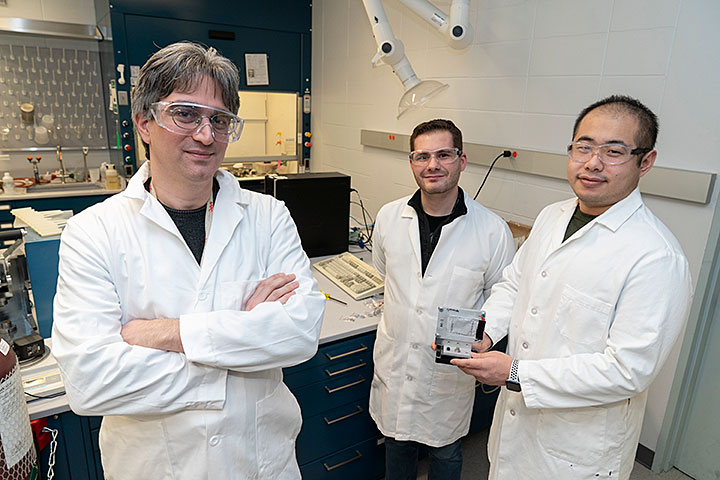Feb 6 2020
Engineers make great efforts to develop a dependable power grid that can preserve renewable energy for use in the days to come, electric vehicles that can drive for many miles on just a single charge, and smartphones that have longer-lasting batteries.
 Corresponding author Peter Khalifah (left) with his students/co-authors Gerard Mattei (center) and Zhuo Li (right) at one of Brookhaven’s chemistry labs. Image Credit: Brookhaven National Laboratory.
Corresponding author Peter Khalifah (left) with his students/co-authors Gerard Mattei (center) and Zhuo Li (right) at one of Brookhaven’s chemistry labs. Image Credit: Brookhaven National Laboratory.
But all these technologies can be achieved only if better cathode materials are built by researchers.
So far, the usual method used for improving cathode materials has been to modify the chemical composition of these materials. At the Brookhaven National Laboratory of the U.S. Department of Energy (DOE), chemists have made a discovery about battery performance that shows a unique, different approach for improving cathode materials.
The researchers’ study, published in the Chemistry of Materials journal and featuring in ACS Editors’ Choice, focuses on regulating the amount of structural flaws that occur in the cathode material.
“Instead of changing the chemical composition of the cathode, we can alter the arrangement of its atoms,” stated Peter Khalifah, the corresponding author of the study and chemist at Brookhaven Lab and Stony Brook University.
A majority of the cathode materials currently contain alternating layers of transition metals—such as nickel—and lithium ions. Inside that layered structure, an insignificant number of flaws can be generally detected, implying that atoms from a transition metal, such as nickel, can be found where a lithium-ion is believed to be, and the other way around.
You can think of a defect as a ‘mistake’ in the perfection of the material’s structure. It is known that a lot of defects will lead to poor battery performance, but what we’ve come to learn is that a small number of defects should actually improve key properties.
Peter Khalifah, Study Corresponding Author and Chemist, Brookhaven Lab and Stony Brook University
According to Khalifah, a good cathode material will have two types of properties—electronic conductivity (the electrons can shift well) and ionic conductivity (the lithium ions can shift well).
“The presence of a defect is like poking a hole between the lithium ion and transition metal layers in the cathode,” Khalifah added. “Instead of being confined to two dimensions, the lithium ions and electrons can move in three dimensions across the layers.”
To reach this conclusion, the researchers have to perform highly accurate experiments that quantified the concentration of flaws present in a cathode material with much greater precision than has ever been performed in the past.
The concentration of defects in a cathode material can vary between two and five percent. Before, defects could only be measured with a sensitivity of about one percent. In this study, we measured defect concentration with exquisite accuracy—a sensitivity of a tenth of a percent.
Peter Khalifah, Study Corresponding Author and Chemist, Brookhaven Lab and Stony Brook University
The researchers achieved this accuracy by performing powder diffraction analyses and they did this using data obtained from two DOE Office of Science User Facilities—the Spallation Neutron Source (SNS) at DOE’s Oak Ridge National Laboratory and the Advanced Photon Source (APS) at DOE’s Argonne National Laboratory.
Powder diffraction is a robust research method. It shows the site of individual atoms inside a material by guiding beams of X-rays, electrons, or neutrons at the material and analyzing the way the beams are able to diffract. In this research, the investigators performed neutron measurements at SNS and X-ray measurements at APS.
This work has developed a new way of visualizing structural defects and their relationship to diffraction and scattering strength. I expect in the future for this technique to be used commonly in the battery community to understand defects and structural characterizations of cathode materials.
Saul Lapidus, Physicist, X-Ray Science Division, Advanced Photon Source, Argonne National Laboratory
“The ability to measure the concentration of weakly scattering elements with the sensitivity of a tenth of a percent will also be useful for many other areas of research, such as measuring oxygen vacancies in superconducting materials or catalysts,” added Khalifah.
Thanks to these precise measurements of the concentration of defects, the researchers can subsequently explore the association between flaws and the chemistry of the cathode material.
The scientists eventually created a “recipe” to obtain any type of defect concentration, which can potentially help researchers to produce cathodes from more eco-friendly and cost-effective materials and then further adjust their concentrations of defects for the most favorable battery performance.
The research was funded by DOE’s Office of Energy Efficiency and Renewable Energy, Vehicle Technologies Office. DOE’s Office of Science supported operations at SNS and APS.